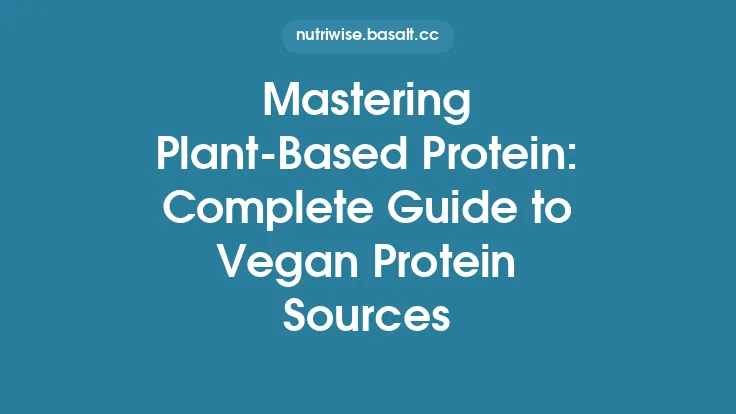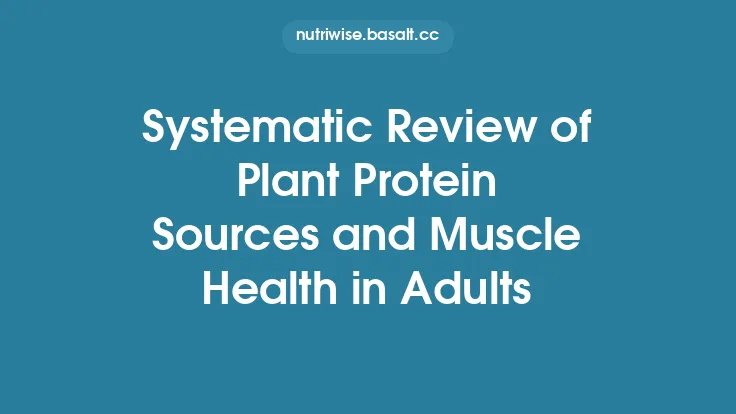Protein is the building block of every cell in the human body, and the ways cultures obtain it are as diverse as the landscapes they inhabit. From the high‑altitude quinoa fields of the Andes to the coastal kelp harvests of the Pacific Northwest, regional food traditions have evolved sophisticated strategies to meet protein needs while respecting local ecosystems, religious practices, and socioeconomic realities. This article explores how different parts of the world combine plant‑based and animal‑based sources to create nutritionally complete diets, examines the science behind protein quality, and offers practical guidance for anyone looking to optimize their protein intake within a culturally informed framework.
Understanding Protein Quality: Amino Acid Profiles and Digestibility
Proteins are composed of 20 amino acids, nine of which are essential because the body cannot synthesize them. The nutritional value of a protein source depends on two key factors:
- Amino Acid Composition – A “complete” protein contains all nine essential amino acids in proportions that meet human requirements. Animal proteins (meat, dairy, eggs, fish) typically meet this criterion, while most single plant proteins are limiting in one or more essential amino acids (e.g., lysine in cereals, methionine in legumes).
- Digestibility – The proportion of ingested protein that is absorbed and utilized. The Protein Digestibility‑Corrected Amino Acid Score (PDCAAS) and the newer Digestible Indispensable Amino Acid Score (DIAAS) are standard metrics. Animal proteins generally score higher, but processing methods (fermentation, soaking, sprouting) can markedly improve the digestibility of plant proteins.
A balanced diet often leverages the complementary strengths of different foods. For example, pairing a grain that is low in lysine (such as rice or wheat) with a legume rich in lysine (like beans or lentils) creates a synergistic protein profile that rivals animal sources.
Plant‑Based Protein Across Regions
1. Cereals and Pseudocereals
- Millet, Sorghum, and Teff – Staple grains in arid and high‑altitude regions. They provide modest protein (8–12 % of dry weight) and are rich in iron and B‑vitamins. Traditional processing (malting, fermentation) reduces antinutrients and enhances amino acid availability.
- Quinoa and Amaranth – Native to the Andean highlands, these pseudocereals are rare among cereals for containing all essential amino acids, particularly lysine, making them valuable in vegetarian diets.
2. Legumes and Pulses
- Cowpea, Mung Bean, and Chickpea – Widely cultivated in sub‑Saharan Africa, South Asia, and the Mediterranean fringe. They are high in lysine and provide 20–25 % protein by weight. Soaking and sprouting reduce phytic acid, improving mineral absorption.
- Soy Variants (Tofu, Tempeh, Natto) – While soy is a cornerstone of East Asian cuisines, its fermented forms (tempeh, natto) are also integral to emerging food cultures in Africa and Latin America, offering enhanced digestibility and probiotic benefits.
3. Nuts, Seeds, and Oil‑seed Cakes
- Groundnuts (Peanuts), Sesame, and Sunflower Seeds – Provide dense protein (25–30 % dry weight) and healthy fats. In many West African and South American communities, groundnut paste (e.g., *mafé* sauce) serves as both a flavor base and a protein booster.
- Pumpkin and Flaxseed – Often incorporated into breads and porridges, they contribute modest protein while delivering omega‑3 fatty acids and lignans.
4. Leafy Greens and Microgreens
- Moringa, Amaranth Leaves, and Watercress – Though lower in total protein, these greens are rich in essential amino acids, especially threonine and tryptophan, and can supplement overall intake when consumed in large quantities.
5. Fermented Plant Products
- Fermented Cassava (Gari, Fufu) – In West Africa, fermentation not only improves safety but also increases protein content through microbial biomass.
- Miso and Fermented Bean Pastes – While originating in East Asia, similar fermentation techniques are being adopted globally to enhance protein quality and add umami flavor.
Animal‑Based Protein in Different Climates and Cultures
1. Ruminant Livestock (Cattle, Sheep, Goats)
- Grass‑Fed vs. Feedlot Systems – In temperate grasslands, extensive grazing yields meat and dairy with higher omega‑3 fatty acids and conjugated linoleic acid (CLA). In arid zones, goats and sheep are preferred for their ability to thrive on sparse vegetation, providing milk, cheese, and meat with relatively low environmental footprints.
2. Poultry and Eggs
- Free‑Range Chickens and Ducks – In Southeast Asian rice paddies, ducks forage on insects and aquatic plants, enriching egg yolk with DHA. Smallholder poultry systems in Latin America and Africa often integrate birds into household waste management, turning kitchen scraps into high‑quality protein.
3. Aquatic Resources
- Freshwater Fish (Tilapia, Catfish) – Cultivated in ponds and rice‑field aquaculture across South and Southeast Asia, these species grow quickly and have protein digestibility scores above 90 %.
- Marine Fish and Shellfish – In coastal communities, small pelagic fish (sardines, anchovies) are consumed whole, preserving bones and providing calcium alongside protein. Shellfish such as mussels and oysters are rich in zinc and vitamin B12.
4. Insects and Emerging Animal Proteins
- Edible Insects (Crickets, Mealworms, Locusts) – Traditional in parts of Africa and Central America, insects offer 50–65 % protein with a favorable amino acid profile and low greenhouse gas emissions. Processing into flours enables incorporation into baked goods and protein bars.
- Cultured Meat and Algal Proteins – While still emerging, pilot projects in Nordic and East Asian research hubs are exploring scalable production of lab‑grown muscle tissue and spirulina, which could complement regional diets in the future.
Integrating Plant and Animal Proteins for Balanced Nutrition
A truly optimized protein strategy leverages the strengths of both domains:
- Complementary Pairings – Combining legumes with cereals (e.g., rice‑bean, corn‑bean) creates a complete amino acid profile while diversifying micronutrient intake.
- Mixed Meals – A typical balanced plate might include a portion of grilled fish (high‑quality animal protein), a side of quinoa salad (plant protein and fiber), and a garnish of roasted pumpkin seeds (healthy fats and additional protein).
- Timing and Distribution – Research indicates that spreading protein intake evenly across meals (≈20–30 g per meal) maximizes muscle protein synthesis, especially for older adults. Traditional eating patterns that feature a protein‑rich breakfast (e.g., soy milk and millet porridge) and a lighter dinner align well with this principle.
Practical Strategies for Optimizing Protein Intake
- Assess Local Availability – Identify the most abundant protein sources in your region (e.g., beans in Central America, fish in coastal Bangladesh) and prioritize them to reduce cost and environmental impact.
- Utilize Traditional Processing – Adopt age‑old techniques such as soaking, sprouting, fermenting, and slow cooking to improve digestibility and nutrient bioavailability.
- Diversify Protein Sources – Aim for at least three distinct protein categories per week (legume, grain, animal) to ensure a broad spectrum of amino acids and micronutrients.
- Mind Portion Sizes – For most adults, 0.8–1.0 g of protein per kilogram of body weight per day is sufficient; athletes or pregnant individuals may require 1.2–1.7 g/kg. Adjust portions of high‑protein foods accordingly.
- Consider Sustainability – Favor low‑impact options such as plant proteins, small fish, and insects when possible. When consuming larger livestock, choose locally raised, pasture‑based products to minimize transport emissions.
- Monitor Micronutrient Balance – Ensure adequate intake of iron, zinc, vitamin B12, and omega‑3 fatty acids, which can be limiting in predominantly plant‑based diets. Fortified foods or modest animal‑source inclusion can address these gaps.
Cultural Considerations and Sustainable Choices
- Religious and Ethical Norms – Many cultures observe fasting periods or avoid certain animal products (e.g., pork in Islamic communities, beef in Hindu traditions). Understanding these constraints is essential for designing acceptable protein plans.
- Seasonality – In agrarian societies, protein sources often shift with the seasons (e.g., dried fish in the dry season, fresh legumes in the rainy season). Seasonal eating not only respects cultural rhythms but also enhances food security.
- Gender Roles and Labor – In some regions, women are primary caregivers and food preparers, influencing the selection and preparation of protein foods. Empowering women through nutrition education can have a multiplier effect on household protein adequacy.
- Economic Access – While high‑quality animal proteins may be prized, they can be cost‑prohibitive for low‑income families. Community‑based initiatives such as cooperative poultry farms or shared fish ponds can democratize access.
Future Directions and Research Priorities
- Biofortification of Staple Crops – Developing high‑protein, lysine‑enriched varieties of millet, sorghum, and rice through conventional breeding or gene editing could dramatically improve protein quality in regions reliant on these grains.
- Optimizing Fermentation Microbiomes – Tailoring starter cultures to local legumes and cereals may enhance protein digestibility and introduce probiotic health benefits.
- Life‑Cycle Assessment of Regional Protein Systems – Comparative studies that quantify greenhouse gas emissions, water use, and land footprint for different regional protein pathways will guide policy and consumer choices.
- Nutrigenomics and Personalized Nutrition – Investigating how genetic variations affect protein metabolism across populations can inform culturally specific dietary recommendations.
- Scaling Insect and Algal Production – Research into cost‑effective rearing, processing, and consumer acceptance of insects and microalgae will determine their role in future regional diets.
Concluding Thoughts
Regional protein sources are a testament to human ingenuity—adapting to climate, geography, cultural values, and economic realities to meet a fundamental nutritional need. By appreciating the scientific underpinnings of protein quality, honoring traditional processing methods, and embracing sustainable practices, individuals and communities can craft diets that are both nutritionally robust and culturally resonant. Whether you are savoring a bowl of quinoa‑bean stew in the Andes, enjoying a modest serving of fermented soy in a West African market, or incorporating locally raised fish into a coastal Asian meal, the principles outlined here can help you optimize protein intake while staying true to the rich tapestry of regional food traditions.





